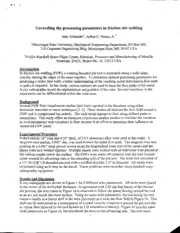
NASA Technical Reports Server (NTRS) 20050209919: Unraveling the Processing Parameters in Friction Stir Welding PDF
Preview NASA Technical Reports Server (NTRS) 20050209919: Unraveling the Processing Parameters in Friction Stir Welding
. C. Unraveling the processing parameters in friction stir welding Judy Schneider’, Arthur C. Nunes, Jr.2 1M ississippi State University, Mechanical Engineering Department, PO Box ME, 2 10 Carpenter Engineering Bldg, Mississippi State, MS 39762 USA 2N ASA-Marshall Space Flight Center, Materials, Processes and Manufacturing of Metallic Materials, EM33, Huntsville, AL 35812 USA Introduction In fiiction stir welding (FSW), a rotating threaded pin tool is translated along a weld seam, literally stirring the edges of the seam together. To determine optimal processing parameters for producing a defect fiee weld, a better understanding of the resulting metal deformation flow path or paths is required. In this study, various’markers are used to trace the flow paths of the metal. X-ray radiographs record the segmentation and position of the wire. Several variations in the trajectories can be differentiated within the weld zone. Backoround Several FSW flow visualization studies have been rcpoited in the litemtiare ushg either dissimilai materials or tracer techniques 11-51. These setdies all indicate the flow field vound a FSW tool is complicated but orderly. Tie weid metai appears IO flow dong deiimed p-a+L‘n s or streamlines. This study offers an extension of previous marker studies to correlate the variation in w-eld parameters wit3 vzriations in flow strezras iii iiii effort to determine tkir idhe~coen optimized FSW joints. Experimental Procedure Rolled panels, 24” long and 0.25” thick, of 2219 aluminum alloy were used in this study. A tungsten wire marker, 0.001” dia., was used to trace the metal flow path. The tungsten wire was position in a 0,001” deep groove scored along the longitudinal seam side of the panels and the .p_la tes werctxckmlddtogetna. M-dtiple p-anels were welded with an individu~-wireplaced-~t- the various depths below the surface, The FSWs were made off-centered with the wire located either toward the advancing side or the retreating side of the pin tool. The weld tool consisted of a 1/2-20 UNF LH threaded pin tool with a scrolled shoulder 1.2” in diameter. All welds were termhated ;;s‘.l;g an E-stop on the travel. Tracer positions were recorded usiog stanckrd x-rzy radiography equipment. Results and.Discussion X-ray radiographs are shown in Figure 1 for 3 different wire placements. All wires were placed in the center of the weld plate thickness. In agreement with 2-D slip line theory of the fTiction stir process, the wire tracer in Figure 1a is observed to follow the metal flowing around the tool in an arc just inside the shear surface. Using the same weld parameters, but increasing the tool rotation results in a lateral shift in the m*e placement as it exits the flow field in Figze 1b. This shift can be understood as a consequence of a radial velocity component around the pin tool due to vortex flow induced by the tool threads (a 3-D extension of theory). Figure ICu ses the same weld parameters as Figure la, but introduces the wire on the advancing side. The wire trace appears to follow a relatively slow induced circumferential flow, entering a much faster flow when a streamline passes sufficiently close to the tool. Under the latter condition scatter occurs. The scatter may be a consequence of imprecise encounters with a sharp change in circumferential velocity or of a radial oscillation of the flow field at the tool shoulder. Figure 1. Vsrrying marker traces resulting from tungsten wire marker introduced at center thichess ef weld j&t. z) wire ktrodrrced on retreating side of weld; b) wire introduced on retreating side of weld at slightly higher qm, c) wire introduced at center ilne of weld. Summary and Conclusion Thin tungsten wire markers can be used to trace the metal flow path during hction stir welding. As the wire is entrained in the shear zone surrounding the weld tool, it segments into uniform lengths. Entrainment of the marker into a downward, vortex flow is observed when the wire is - zintroduced-on-theI-etreating-si&-ofthe weld at a higher weld rpm; Scatter in the post-weld- - - marker placement, initially introduced on the advancing side of the weld, suggests high rotating velocities very close to the pin circumference and possible radial oscillations of the flow field. R-eferences 1. Y. Li, L.E. Murr, J.C. McClure, Scripta mater., 40 191 (1999) 1041-1046 2. Y.L i, L.E. Murr, J.C. McClure,Mut. Sci. & Engr. A, 271A (1999) 213-223. ?? K. Colligan, Weldkg Resezch (I 999) 229s-237s. -1 4) T.U. Seidel, A.PI Reynolds, Met. & Mat. Trans. A., 32A (2001) 2879-2884. 5. J.A. Schneider and A.C. Nunes, Jr., Friction Stir Pelding and Processing II, ed. K.V Jab, M.W. Mahoney, R.S. Mishra, S.L. Sematin, T. Lienert, (2003) 43-51.
